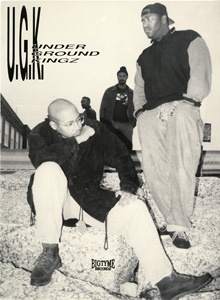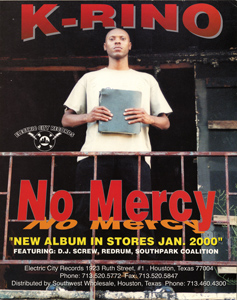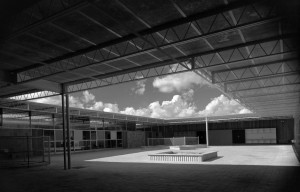

Underground Kingz (UGK), from the Houston Hip Hop Recording Artists Collection at the University of Houston Special Collections
The University of Houston Special Collections is pleased to announce that the finding aid for the Houston Hip Hop Recording Artists Collection has recently been published and is now available online. Incorporating a number of smaller collections donated by local rappers, DJs, businesses, and other members of the hip hop community, the Houston Hip Hop Recording Artists Collection contains promotional materials, photographs, and publications documenting the unique Houston hip hop scene from the 1990s through the present day.
Back in 1991 Chuck D was quoted as saying “Rap is CNN for black people,” expressing the frustrations of communities bewildered by the lack of attention or concern from the mainstream media. These untold stories would take root in freestyles, find themselves scribbled in notebooks, and performed on stages in front of audiences of different sizes and, eventually, different colors.
Music like hip hop, that establishes its presence organically outside of mainstream radio and record labels, is typically of interest in what it has to say not only in and of itself, but also what it has to say about the community from which it originates. Much in the same manner that scholars and researchers flocked to the study of jazz as a means of shedding light on the Great Migration of the early twentieth century, those interested in what CNN (and the others) missed along the way have turned to the study of hip hop. Unseen or unspoken in Chuck D’s quote is that hip hop became not only a national news network for otherwise uncovered topics, but it also became a local or micro news network, reflecting the specific anguish and joy of the individual communities which molded and shaped this genre to fit a particular need.

K-Rino, from the Houston Hip Hop Recording Artists Collection at the University of Houston Special Collections
While the hip hop scenes of the West and East Coasts have received most of the limelight (and now study), the hip hop scene of our Third Coast or Dirty South might find itself shortchanged. Our Houston Hip Hop collections help to fill that void, promising some exciting research potential. In looking at the Houston Hip Hop Recording Artists Collection, coupled alongside the DJ Screw Papers, researchers are able to gain an understanding of how and why this particular, regional scene evolved in the manner it has and the myriad of ways it differs from its brethren on either coast.
Please give the new finding aid a look and come visit us when you are ready to take advantage of these uniquely Houston resources.
The following comes to us from Dr. Stephen James. Dr. James holds a Ph.D. in Architectural History from the University of Virginia and for many years was a lecturer at the University of Houston College of Architecture. He began working with architectural archives at the University of Virginia Library, and at UH Special Collections he has been responsible for most of the Architecture and Planning collections, including Donald Barthelme, Sr.; Burdette Keeland , Jr.; and Doug Michels. He is currently working on the Kenneth E. Bentsen papers.
Many people are familiar with the work of writer Donald Barthelme but don’t know that he grew up in the shadow of his noted father, Donald Barthelme, Sr., a nationally prominent architect. Barthelme Sr. first attracted attention as the lead designer for the Hall of State at the Texas State Fairgrounds in Dallas (1936)—now considered a masterpiece of Art Deco. Twelve years later the American Institute of Architects honored him for his design for St. Rose of Lima Catholic Church in Houston (1948). Yet he made his reputation with his award-winning West Columbia Elementary School (1952), which was published widely.
Barthelme was a humanist who deplored architects’ fixation with aesthetics and style. Instead, he tried to enhance the physical experience of a building’s occupants. His innovative design for West Columbia dispensed with the long corridors of traditional schools by organizing the building around two large courtyards. Classrooms looked out on the courts through floor-to-ceiling glass, which admitted natural light and allowed views into the courts. Additional lighting came from large skylights. Courtyards and skylights were Barthelme trademarks and appeared in most of his buildings.
Throughout the 1950s, Barthelme was one of the best-known architects in Houston. A larger-than-life figure, he was a local celebrity who drove a sporty convertible and charmed the newspaper columnists. He cultivated the image of a loner who went his own way rather than follow the crowd. He had extremely high standards and insisted on doing things the “right way,” but this idealism sometimes alienated others.
Barthelme’s long relationship with the University of Houston began in 1946 as a member of the architecture department’s original faculty. He taught design and other courses there until his retirement in 1974, influencing countless students along the way. From 1959 to 1961 he was the chairman of the architecture department at Rice University.
Still, there was more to Barthelme’s life than architecture. In their modernist house off Post Oak Lane, he and his wife Helen Bechtold Barthelme nurtured five children in an atmosphere that encouraged creativity. Three of them—Donald, Frederick, and Steven—became important writers and, like their father, also mentored others. Donald was instrumental in the growth of the Creative Writing Program at the University of Houston, while Frederick and Steven have directed The Center for Writers at the University of Southern Mississippi. To learn more about this remarkable family, read Frederick and Steven Barthelme’s memoir, Double Down: Reflections on Gambling and Loss (1999). Further information about Donald Barthelme Sr. can be found in the Donald Barthelme Sr. Architectural Papers at Special Collections.
* Editor’s note: The original text of this post has been updated to more accurately reflect Donald Barthelme’s role in the UH Creative Writing Program.

